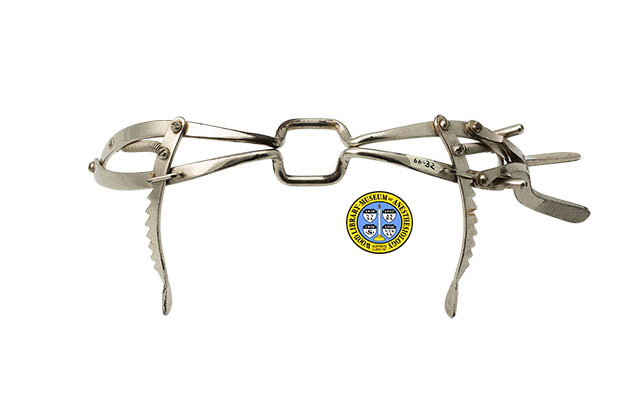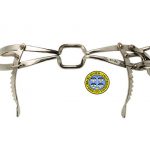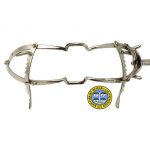Whitehead Mouth Gag
Anesthesiologists are responsible for maintaining the patient's respiration and other vital functions during surgery. Mouth gags are sometimes used to hold the patient's mouth open for dentistry, oral surgery and anesthesia. Surgical procedures for the repair of cleft palate began in the 18th Century, and the first successful cleft palate surgery in the United States was performed in 1820 by John Collins Warren (1778-1856). Since the mid-19th Century, many mouth gags have been designed specifically for these surgeries. One of the most enduring of these gags was introduced by the adventurous American physician William R. Whitehead, M.D. (1831-1902).
Born in Virginia, Dr. Whitehead served as a surgeon during Crimean war (1853-1856), under the Russian surgeon Nikolai Pirogov (1810-1881.) He served as a surgeon in the Confederate Army during the American Civil War (1861-1865) and tended General "Stonewall" Jackson (1824-1863) at the battle of Chancellorsville. He later practiced in New York City, where he introduced his cleft palate gag in 1869. In 1874, he moved to Denver Colorado, where he spent the rest of his life. His mouth gag features an attached tongue depressor (lacking in this example) and is adjusted by a ratchet at each corner. It was modified by J. Ellis Jennings, M.D. in 1914. Both the Whitehead and Jennings gags are still made today.
Catalog Record: Whitehead Mouth Gag Whitehead Mouth Gag
Access Key: aqtf
Accession No.: 66-32
Title: [Whitehead mouth gag / designed by William R. Whitehead].
Author: Whitehead, William Riddick, 1831-1902.
Physical Description: [Place of manufacture not indicated] : [Name of manufacturer not indicated], [between 1869 and 1966].
Subject: Airway Management – instrumentation.
Subject: Anesthesia, Inhalation – instrumentation.
Subject: Mouth Gags.
Note Type: General
Notes: The first year in the date range is the year of introduction. The second year in the date range is the date that the object was acquired; the object’s fragility suggests that it is likely to have been made much earlier.
Note Type: General
Notes: The book “Adventures of an American Surgeon” was published by Dr. Whitehead’s descendants in 2002, and is a reproduction of a manuscript owned by the National Library of Medicine. The original manuscript is dated 1902 and is titled: “The Life and Experiences of an American Surgeon: Including Experiences in Sevastopol during the Crimean War”.
The ADAIR website incorrectly attributes the Whitehead mouth gag to the English surgeon Walter Whitehead, who wrote on excision of the tongue.
Note Type: Citation
Notes: Albin M. The wounding, amputation and death of Thomas Jonathan “Stonewall” Jackson – some medical and historical insights. Bulletin of Anesthesia History. October, 2001;19(4):1, 4-7 and 15-16.
Note Type: Citation
Notes: Ancestry.library.com. Accessed June 16, 2017.
Note Type: Citation
Notes: Austrian Difficult Airway/Intubation Registry, Virtual Museum of Equipment for Airway Management. http://www.adair.at/eng/museum/equipment/mouthgags/whiteheadobject01.htm. Accessed June 13, 2017.
Note Type: Citation
Notes: Dr. William Riddick Whitehead. https://www.findagrave.com/memorial/120221997. Accessed December 13, 2017.
Note Type: Citation
Notes: Grupa mImport. Knebel double ratched mouth gag [Video]. https://www.youtube.com/watch?v=gsWvawiCjjc. Accessed June 28, 2017.
Note Type: Citation
Notes: Jennings JE. The complete removal of the tonsil in its capsule (Sluder method) by means of a new tonsillotome. Medical Fortnightly. 1914; 45:56-58.
Note Type: Citation
Notes: Leow A-M, Lun-Jou L. Palatoplasty: evolution and controversies. Chang Gung Med J. 2008;31(4):335-345.
Note Type: Citation
Notes: Millard DR. Cleft Craft, vol. 3: Alveolar and Palatal Deformities:141-157. In: University of Miami, Leonard M. Miller School of Medicine, Louis Calder Memorial Library website, electronic books webpage. http://calder.med.miami.edu/Ralph_Millard/cleftcraft/Vol%203/01%20-%20Basics/06.pdf. Accessed June 14, 2017.
Note Type: Citation
Notes: Owens JE. Staphyloraphy and uranoplasty. Chicago Medical Journal. February, 1874;31(2):65-74.
Note Type: Citation
Notes: Powers & Anderson. Illustrated Catalogue of Surgical Instruments and of Allied Lines. Richmond, Virginia: Powers & Anderson, Inc., 1917:355.
Note Type: Citation
Notes: Tiemann, George, & Co. Catalogue of Surgical Instruments. New York: George Tiemann & Co. 1876:60.
Note Type: Citation
Notes: Tyler LG. Encyclopedia of Virginia Biography, Volume III. New York: Lewis Historical Publishing Company, 1915:363-364.
Note Type: Citation
Notes: University of Colorado Denver website. http://www.ucdenver.edu/about-us/history/Pages/default.aspx. Accessed December 18, 2017.
Note Type: Citation
Notes: Whitehead, WR. Report on the best methods of treatment for different forms of cleft palate. Transactions of the American Medical Association of Philadelphia: Collins, 1869.
Note Type: Citation
Notes: Whitehead, WR. Dr. Whitehead’s Gag and his Cleft Palate Cases. Rocky Mountain Medical Times. 1882;1:194-200.
Note Type: Physical Description
Notes: One mouth gag; Consists of two scalloped metal struts; The struts are connected to one another by two hinges, one at each outside corner; They are further connected by two handles on the user’s right, one screwed to the upper strut and one to the lower strut; Each handle ends in a flat, striated paddle; The handles are pushed apart or brought together by operating two ratchets, one on the left and one on the right; Each ratchet is screwed to the upper strut, and its range of motion is constrained by a bar on the lower strut; The upper end of each ratchet is connected by a spring to the upper strut; The WLM accession number “66-32” is painted on the lower strut; The cataloged object lacks that part which acts as a tongue depressor; The dimensions of the gag are the same whether open or closed.
Note Type: Reproduction
Notes: Photographed by Mr. Steve Donisch, January 16, 2018.
Note Type: Acquisition
Notes: Gift of the Mayo Clinic, Rochester, MN.
Note Type: Historical
Notes: Anesthesiologists are responsible for maintaining the patient’s respiration and other vital functions during surgery. Mouth gags are sometimes used to hold the patient’s mouth open for dentistry, oral surgery and anesthesia. Surgical procedures for the repair of cleft palate began in the 18th Century. The first successful cleft palate surgery in the United States was performed in 1820 by John Collins Warren (1778-1856). Since the mid-19th Century, many mouth gags have been designed specifically for these surgeries. One of the most enduring of these was introduced by the adventurous American physician William R. Whitehead (1831-1902).
Born in Virginia, Dr. Whitehead received his medical degree from the University of Pennsylvania in 1853. He served under the Russian surgeon, Nikolai Pirogov (1810-1881) during the Crimean war (1853-1856). In 1847, Dr. Pirogov became the first Russian physician to use ether for surgical anesthesia. In 1860, Dr. Whitehead received a second medical degree from the University of Paris and was then appointed Professor of Clinical Medicine at New York Medical College. Upon the outbreak of the American Civil War (1861-1865) he returned to Virginia and served as a surgeon in the Confederate Army. He tended General “Stonewall” Jackson at the battle of Chancellorsville. After the war he practiced medicine in New York City, where he introduced his cleft palate gag in 1869. He moved to Denver, Colorado in the 1870s, where he spent the rest of his life. He is credited with being a cofounder of the Denver College of Medicine (later merged with the University of Colorado School of Medicine), and with serving several terms as President of the Colorado Medical Society.
The Whitehead gag has a built-in tongue depressor. It is adjusted by two spring-loaded ratchets, one on the left side and one on the right. This design was simplified by J. Ellis Jennings, M.D., in 1914. Both the Whitehead and Jennings gags are still being made today.
Note Type: Publication
Notes: Sherlock T. Colorado’s Healthcare Heritage: A Chronology of the Nineteenth and Twentieth Centuries, Volume One – 1800-1899. Bloomington, Indiana: iUniverse, 2013.
Note Type: Publication
Notes: Whitehead WR. Adventures of an American Surgeon: a 19th Century Memoir. Bethesda, Maryland: Whitehead Books, 2002.
Note Type: Exhibition
Notes: Selected for the WLM website.



